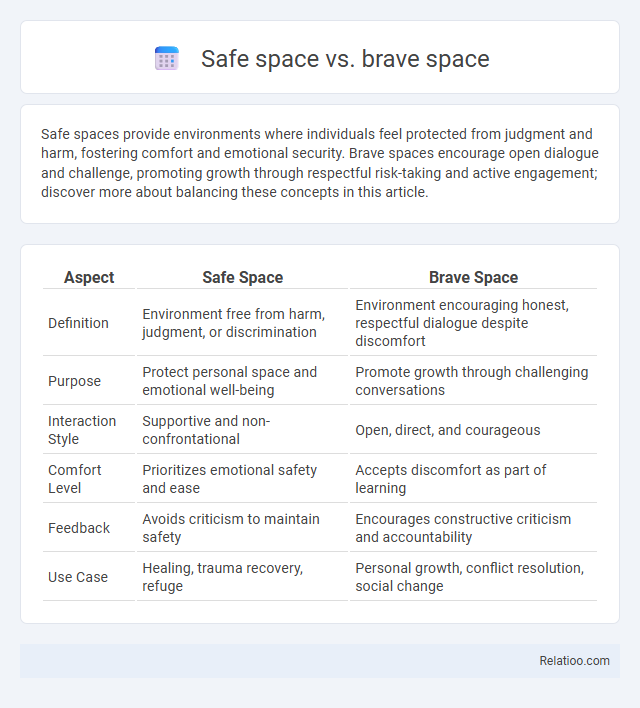Safe spaces provide environments where individuals feel protected from judgment and harm, fostering comfort and emotional security. Brave spaces encourage open dialogue and challenge, promoting growth through respectful risk-taking and active engagement; discover more about balancing these concepts in this article.
Table of Comparison
| Aspect | Safe Space | Brave Space |
|---|---|---|
| Definition | Environment free from harm, judgment, or discrimination | Environment encouraging honest, respectful dialogue despite discomfort |
| Purpose | Protect personal space and emotional well-being | Promote growth through challenging conversations |
| Interaction Style | Supportive and non-confrontational | Open, direct, and courageous |
| Comfort Level | Prioritizes emotional safety and ease | Accepts discomfort as part of learning |
| Feedback | Avoids criticism to maintain safety | Encourages constructive criticism and accountability |
| Use Case | Healing, trauma recovery, refuge | Personal growth, conflict resolution, social change |
Understanding Safe Spaces: Definition and Origins
Safe spaces are environments designed to provide individuals with emotional and psychological security, promoting open expression without fear of judgment or harm. Originating from activist and educational movements in the late 20th century, safe spaces aim to protect marginalized groups by fostering inclusivity and respect. These spaces prioritize vulnerability and support, distinguishing them from brave spaces, which emphasize challenging dialogue and growth through discomfort.
The Concept of Brave Spaces: What Sets Them Apart
Brave spaces encourage open dialogue where individuals confront challenging topics with honesty and respect, fostering growth through vulnerability and active listening. Unlike safe spaces that prioritize emotional comfort, brave spaces emphasize the importance of discomfort as a catalyst for learning and social change. Your engagement in a brave space supports personal and collective transformation by balancing safety with courage.
Core Principles: Safe Space vs Brave Space
Safe space emphasizes creating an environment where individuals feel protected from judgment, harm, or discrimination, prioritizing emotional safety and respect. Brave space encourages open dialogue and risk-taking in conversations about challenging topics, fostering growth through honesty, vulnerability, and mutual accountability. Core principles of safe space focus on protection and inclusivity, while brave space centers on courage, active engagement, and transformative learning.
Historical Context and Evolution
Safe spaces originated in the 1960s during civil rights movements as environments protecting marginalized groups from discrimination and trauma. Brave spaces emerged in the 2010s to encourage open dialogue and confronting difficult conversations while maintaining respect. The evolution from safe to brave spaces reflects shifting priorities from protection to active engagement in social justice and diversity discourse.
Inclusivity and Expression: Balancing Needs
Safe spaces prioritize creating an environment free from harm where Your emotional and physical safety is protected, fostering inclusivity through boundaries that minimize potential triggers. Brave spaces encourage open dialogue and the expression of diverse perspectives by inviting constructive discomfort, promoting growth while respecting individual experiences. Balancing these needs involves establishing clear guidelines that honor both the protection of marginalized voices and the essential freedom to challenge ideas for deeper understanding.
The Role of Facilitators in Both Spaces
Facilitators in safe spaces prioritize creating an environment free from judgment and harm, ensuring participants feel secure to share personal experiences and emotions. In brave spaces, facilitators encourage courageous dialogue and critical thinking, guiding individuals to engage in challenging conversations while maintaining respect and openness. Your role as a facilitator involves balancing empathy and boundary-setting to foster trust and growth in both safe and brave spaces.
Challenges and Criticisms of Safe Spaces
Safe spaces are designed to provide environments free from discrimination, harassment, or judgment, but they face criticism for potentially limiting open dialogue and shielding participants from uncomfortable but necessary conversations. Critics argue that safe spaces may inadvertently promote intellectual echo chambers by discouraging exposure to diverse viewpoints and constructive debate. Challenges also include balancing protection with free speech and avoiding the suppression of dissenting opinions in educational or social settings.
Debates Around Brave Spaces: Pros and Cons
Debates around brave spaces highlight the importance of fostering environments where individuals can engage in honest and challenging conversations without fear of censorship, promoting personal growth and social change. Critics argue brave spaces may expose participants to emotional discomfort or conflict, potentially alienating marginalized groups seeking psychological safety. Proponents emphasize that brave spaces encourage vulnerability and resilience by balancing respect with accountability, contrasting with traditional safe spaces that prioritize emotional security over open dialogue.
Practical Applications in Education and Workplaces
Safe spaces in education and workplaces prioritize creating environments free from discrimination and judgment, ensuring individuals feel protected and respected. Brave spaces encourage open dialogue and constructive conflict, promoting growth through honest conversations and challenging perspectives. Integrating both approaches fosters inclusive settings where emotional safety coexists with courageous engagement, enhancing learning outcomes and collaborative productivity.
Creating Effective Spaces: Strategies and Best Practices
Creating effective spaces involves understanding the nuances between safe space, brave space, and brave safe space to foster open and respectful dialogue. Safe spaces prioritize emotional security and protection from harm, while brave spaces encourage courage and vulnerability to engage in difficult conversations; integrating these approaches supports Your goal of inclusivity and growth. Implement strategies such as establishing clear guidelines, promoting active listening, and encouraging empathy to balance safety with bravery and cultivate an environment conducive to learning and connection.

Infographic: Safe space vs Brave space
 relatioo.com
relatioo.com